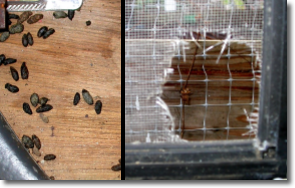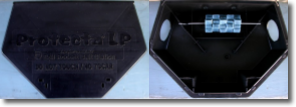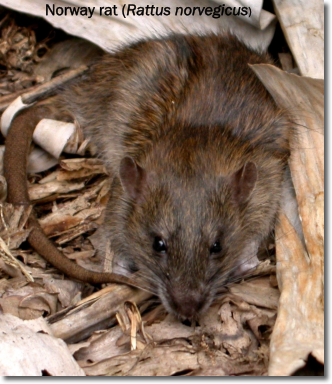Rodent Program
Rodents are more than a nuisance. They have the potential to harm people through direct or indirect transmittal of disease. They can carry at least 10 types of diseases including: leptospirosis, murine typhus, plague (no longer in Hawaii), and salmonellosis. They foster parasites such as fleas, lice, mites, and Angiostrongylus sp. nematodes that cause rat lungworm disease.
Rats and mice are readily detected by the presence of their droppings or fecal pellets, damaged objects from gnawing, holes in screens or around pipes, and dirty “grease” marks along their runways. An infestation will often have an unmistakable urine odor as well.
Biology and ecology.
Rats and mice breed year-round in Hawai’i. The most common rat species associated with complaints in Hawaii are the roof rat (Rattus rattus) and the Norway Rat (Rattus norvegicus). The roof rat is an excellent climber and is found inhabiting trees, roof spaces and attics.

Roof rat droppings (left) and screens with gnawed holes are sure signs of an infestation. A bench near the window allowed easy access (right).
The Norway rat is often found digging and burrowing under structures but is quite capable of climbing. Both species will range up to 150 feet from their harborage. The Polynesian rat (Rattus exulans) is also found in the islands; it does not often inhabit human dwellings but rather is associated with agricultural lands and certain ecological niches. Rats generally produce about 20 offspring/year in litters of 4-8 young.
They have about a 3 week gestation period and begin breeding at about 3 months of age. Mice (house mouse; Mus musculus) are known for more extreme population growth because of rapid sexual maturation (5-6 wks), short gestation (19-21 days) and large litter sizes (up to 14 young).
Under ideal circumstances, a female can produce about 50 young/year with a case where a population of 50 mice increased to more than 2,000 individuals in 6 months. Mice forage only 10-30 feet from the nest. Young rats and mice are often the stage responsible for new infestations due to their dispersing nature. Occasionally food or water sources will become limited within an area and cause large portions of a population to migrate and search for more favorable conditions.
Permanent control and prevention.
Rodent proofing or exclusion is one of the best proactive steps one can take to prevent or eliminate infestations. This involves closing any openings larger than 1/4 inch (mice) or 1/2 inch (rats). Hardware cloth (19 gauge), sheet metal (26 gauge), and cement mortar or concrete are suitable materials. Wood can be used for exclusion if edges for gnawing are not present.
Sanitation is another method of rodent management. Eliminating food, water and cover/climbing sources are key to this strategy. Store pet food in rodent proof containers and do not leave excess food in pet dishes for extended periods of time. Gather ripe fruit in your yard and surrounding areas. Dry up water sources when possible. Clean up garbage and rubbish. Remove tree limbs overhanging roofs. Eliminate harborage areas inside and outside the home. Piles of wood, boxes, or any other things that provide protection can foster a rodent population.
Traps.
Trapping is very effective for controlling rats and mice and is often underrated. The key for successful trapping is to place traps where rodents are. Mice are generally curious and will readily approach traps.
Traps for mice should be moved after a few nights if they do not catch mice. Rats, on the other hand, are very cautious and may wait a week or more before approaching a trap. For rats it is sometimes helpful to place unset traps in an area for a few days prior to setting them. Traps can be baited with many different items such as: nuts, raisins, sardines, coconut, peanut butter, and gum drops. Cotton can even be used as both rats and mice collect nesting material. Set traps at right angles to runs, along beams, rafters, or walls, and behind furniture. Be sure to place traps where children or pets will not be hurt.

Unbaited “runway” traps with enlarged triggers. Strings can anchor traps to prevent dragging away and loss.
Several snap traps can be placed side by side along a runway and left unbaited. This will catch rats accidentally bumping a trigger as they move along their route. Enlarging the trap triggers with cardboard or screening can increase effectiveness.
Glue or sticky traps can be used in a similar manner as with snap traps. With glue traps the animal remains alive and should be humanely killed before disposal. Single and multi-catch live traps are also available. People who wish to use live traps to catch rodents and release them outdoors should be aware that rodents can quickly find their way back into your or a neighbor’s home.
Pesticide baits.
Baits can be very effective but there are some special considerations with their use. Baits have the potential to harm children, pets and other nontarget wildlife. Caution should be exercised with their use with safety as the primary consideration. Remember it is a violation of federal law to use a pesticide in a manner inconsistent with the label directions.
Read the label carefully. Baits must be used in a manner that only rodents will contact them. This can be accomplished outdoors through the use of tamperproof bait stations. Another consideration with bait usage is the potential that rodents will die in inaccessible areas and create an odor problem.
The odor associated with a dead rat in a confined area can last for weeks and, needless to say, is quite unpleasant. For this reason, baits are not usually the first choice for indoor control. The most common baits available to homeowners are anticoagulants which cause internal bleeding and are often formulated into weather-resistant blocks.

Bait stations ensure bait is not accessible to children or nontarget animals. Stations that do not secure bait within (as above right) need to be anchored in place.
Older products (containing chlorophacinone, diphacinone, warfarin etc) are “multidose” baits requiring more than one feeding. Newer generation anticoagulants (bromadiolone, difethalone) are effective after one dose and may kill rodents resistant to the older products. Like traps, baits/bait stations should be placed where rats live or along runways and travel routes.
There are cases where rats or mice develop an aversion or “shyness” to baits. In such cases, trapping is the most effective means of control.


